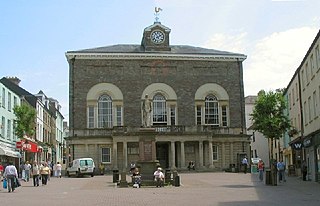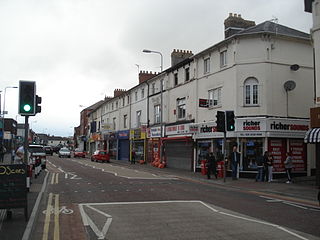
Until 1974, Glamorgan, or sometimes Glamorganshire, was an administrative county in the south of Wales, and later classed as one of the thirteen historic counties of Wales. Originally an early medieval petty kingdom of varying boundaries known in Welsh as Morgannwg, which was then invaded and taken over by the Normans as the Lordship of Glamorgan. The area that became known as Glamorgan was both a rural, pastoral area, and a conflict point between the Norman lords and the Welsh princes. It was defined by a large concentration of castles.

Carmarthenshire is a county in the south-west of Wales. The three largest towns are Llanelli, Carmarthen and Ammanford. Carmarthen is the county town and administrative centre. The county is known as the "Garden of Wales" and is also home to the National Botanic Garden of Wales.

Ammanford is a town and community in Carmarthenshire, Wales, with a population of 5,411 at the 2011 census. It is a former coal mining town. The built-up area had a population of 7,945 with the wider urban area even bigger.

South Wales is a loosely defined region of Wales bordered by England to the east and mid Wales to the north. Generally considered to include the historic counties of Glamorgan and Monmouthshire, south Wales extends westwards to include Carmarthenshire and Pembrokeshire. In the western extent, from Swansea westwards, local people would probably recognise that they lived in both south Wales and west Wales. The Brecon Beacons National Park covers about a third of south Wales, containing Pen y Fan, the highest British mountain south of Cadair Idris in Snowdonia.

Canton is an inner-city district and community in the west of Cardiff, capital of Wales, lying 2 miles (3.2 km) west of the city's civic centre. It is located adjacent to Pontcanna. Canton is one of the most ethnically diverse of Cardiff's suburbs, with a significant Pakistani and Indian population. The total population of Canton increased to 14,304 at the 2011 census. It is also the most Welsh-speaking district of central Cardiff, with 19.1% of the population speaking Welsh.

Cricketers from Wales are currently represented by the England and Wales Cricket Board (ECB) and compete for the England cricket team. There have been some historical instances of a separate Welsh team in the 1920–30s, in the 1979 ICC Trophy, and in the British Isles Championship between 1993 and 2001, however Wales is not a separate member of the International Cricket Council (ICC).

Culverhouse Cross is a district straddling the boundary between Cardiff and the Vale of Glamorgan, Wales, in the community of Wenvoe.
This article is about the particular significance of the year 1967 to Wales and its people.

The A4232, which is also known either as the Peripheral Distributor Road (PDR) (Welsh: Ffordd Ddosbarthu Ymylol) or the Cardiff Link Road (Welsh: Ffordd Gyswllt Caerdydd), is a distributor road in Cardiff, the capital of Wales.
This article is about the particular significance of the year 1908 to Wales and its people.
This article is about the particular significance of the year 1882 to Wales and its people.
This article is about the particular significance of the year 1860 to Wales and its people.

The Glamorgan Building is a former county hall located at King Edward VII Avenue in Cathays Park, Cardiff, Wales. It was the headquarters of Glamorgan County Council from 1912 to 1974 and then of Mid Glamorgan County Council from 1974 to 1996. The building, which was acquired by Cardiff University in 1997 and is now home to the university's School of Social Sciences and the School of Geography and Planning, is a Grade I listed building.
This article is about the particular significance of the year 1780 to Wales and its people.

The timeline of Cardiff history shows the significant events in the history of Cardiff which transformed it from a small Roman fort into the modern capital city of Wales.
The Leckwith development is in the Leckwith area of southwest Cardiff, Wales. Work started in Autumn 2007 with the construction of a new stadium for Cardiff City F.C.
The Farmers’ Union of Wales (FUW), a member organisation, was formed in 1955 to protect and advance the interests of those who derive an income from Welsh agriculture.
This article is about the particular significance of the year 1739 to Wales and its people.
This article is about the particular significance of the year 1726 to Wales and its people.
Emyr Currie-Jones CBE (1917–2008) was a local Labour Party politician in Cardiff, Wales. He was Chairman of South Glamorgan County Council and known for his role in introducing Welsh-language education in Cardiff. He has been described as "an outstanding example of a local councillor who steered Welsh-medium education through many a political storm."












